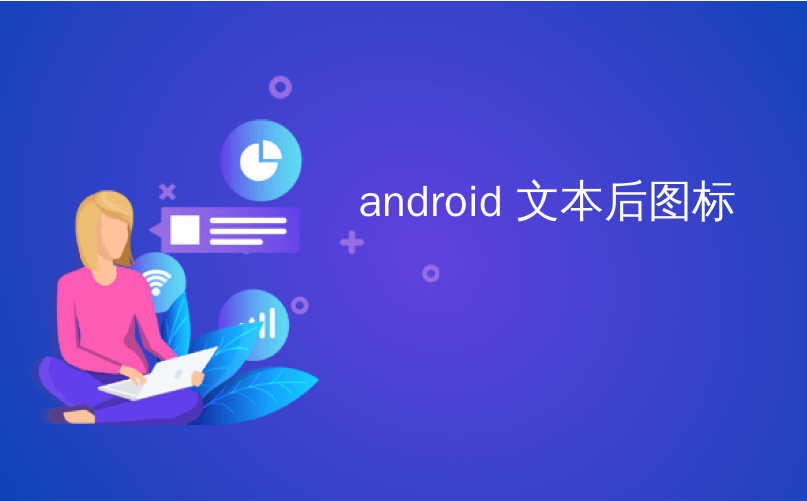
android 文本后圖標
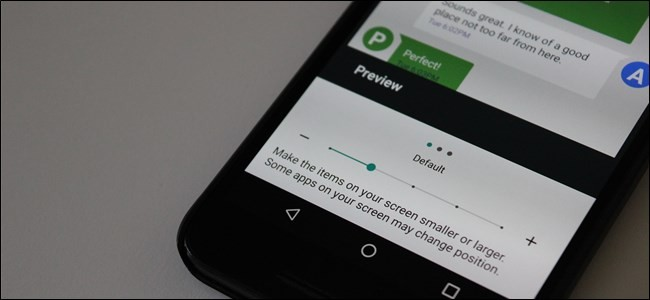
Let’s face it: no matter how good the screens are on our phones and tablets, the text can sometimes be too tiny if you have poor eyesight. The good news is that there are a variety of methods to help you alleviate squinting just to make text (or anything else) more legible.
讓我們面對現實:無論我們手機和平板電腦上的屏幕質量如何,如果視力不好,文本有時可能會太小。 好消息是,有多種方法可以幫助您減輕斜視,從而使文本(或其他任何東西)更清晰易讀。
Depending on what version of Android you’re using (and what type of phone), it’s possible that you may be able to change just the text size, or even make everything on the screen larger. We’re going to talk about all of those options here—as well as a few other things you can do to make your phone easier to see.
根據您使用的Android版本(以及手機的類型),您可能可以僅更改文本大小,甚至可以放大屏幕上的所有內容。 我們將在這里討論所有這些選項,以及可以使手機更易于查看的其他一些操作。
Let’s start with the simplest solutions first.
讓我們先從最簡單的解決方案開始。
如何在Android上更改字體大小 (How to Change the Font Size on Android)
Changing the font couldn’t be easier on most Android phones. I’m using a Pixel XL running Android 7.1.1 Nougat here, but the process should be identical for all devices. Things?may look a little bit different depending on your Android build and phone manufacturer, but otherwise should be similar. For example, Android 7.x includes a preview of what the text will look like, where older versions of the OS simply display the choices with no preview.
在大多數Android手機上,更改字體并非易事。 我在這里使用的是運行Android 7.1.1 Nougat的Pixel XL,但是所有設備的過程都應該相同。 視您的Android版本和手機制造商而定,情況可能會略有不同,但其他方面應該相似。 例如,Android 7.x包含文本外觀的預覽,而較早版本的OS只是顯示選擇而沒有預覽。
Still, you should be able to follow along fairly easily.
不過,您應該能夠相當輕松地遵循。
First, head into the Settings menu. You can do this by pulling the notification shade down (twice on some devices), then selecting the cog icon.
首先,進入“設置”菜單。 您可以通過下拉通知欄(在某些設備上是兩次),然后選擇齒輪圖標來做到這一點。
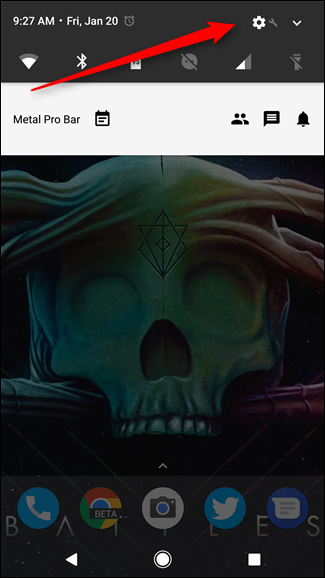
From here, scroll down to the “Display” entry and tap it.?In this menu, look for the “Font size” option.
從此處向下滾動到“顯示”條目,然后點擊它。 在此菜單中,查找“字體大小”選項。
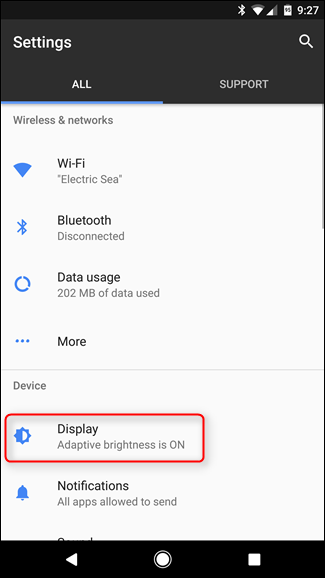
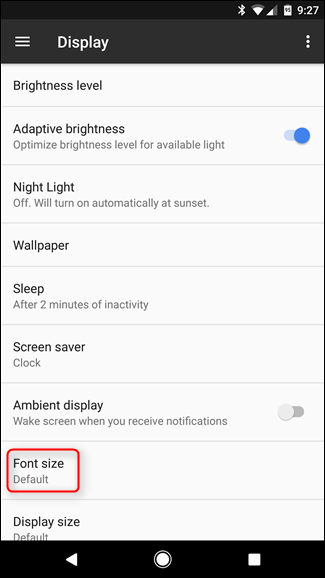
The left screenshot shows what this looks like on 7.x, where the right one is Android 6.x. The same options are available, just with and without the preview.
左邊的屏幕截圖顯示了在7.x上的外觀,右邊的是Android6.x。 可以使用相同的選項,無論是否帶有預覽。
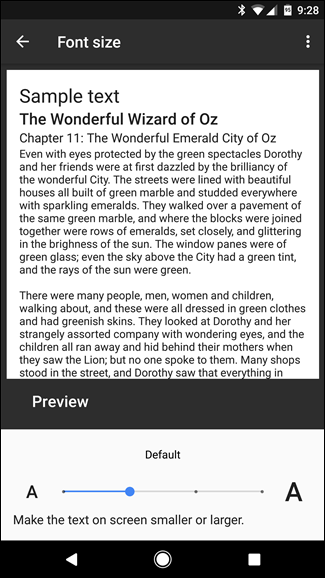
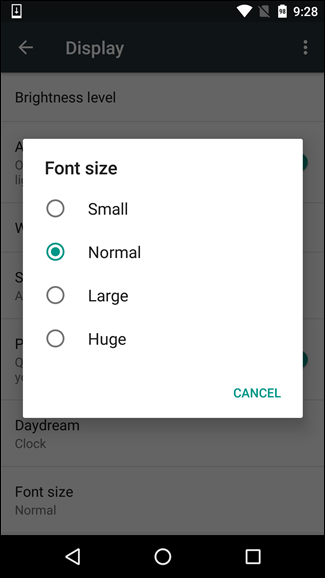
Again, it’s worth noting that this may look even more different depending on your device. For completeness, here’s a look at this menu on Samsung (left) and LG (right) devices.
同樣,值得注意的是,根據您的設備,這看起來可能會更加不同。 為了完整起見,請看一下三星(左)和LG(右)設備上的此菜單。
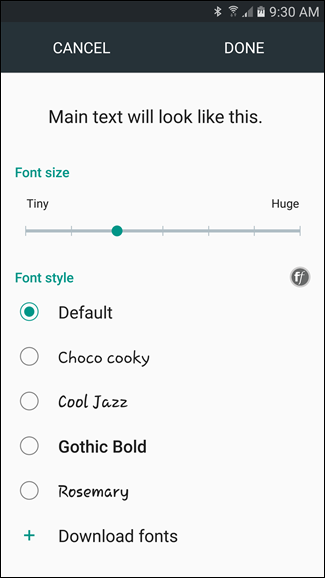
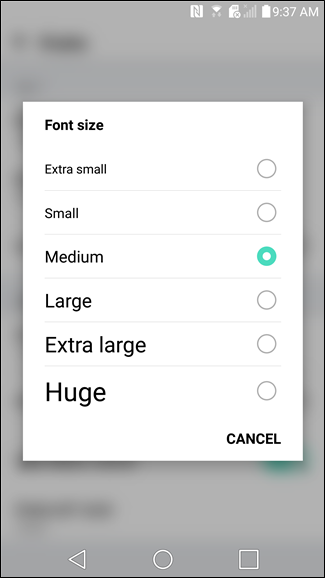
Once you’ve chosen your font, simply back out of this menu and the changes will stick. Nothing to it.
選擇字體后,只需退出此菜單,更改就會保留下來。 沒什么
如何在Android Nougat中更改圖標和其他元素的大小(How to Change the Size of Icons and Other Elements in Android Nougat)
With Android Nougat, Google incorporated a new feature: the ability to not only change font size, but also other display elements.
Google通過Android Nougat引入了一項新功能:不僅可以更改字體大小,還可以更改其他顯示元素。
Essentially, this means everything from the navigation bar to app icons and menus can be made bigger or smaller—think of it like changing the zoom level in Microsoft Windows. For those who want to see more information on the screen, everything can be made smaller. For those who may have limited vision, every element can be made larger, with the largest setting offering a very dramatic change from the stock size.
從本質上講,這意味著從導航欄到應用程序圖標和菜單的所有內容都可以放大或縮小–就像在Microsoft Windows中更改縮放級別一樣。 對于那些想在屏幕上查看更多信息的人,可以將所有內容縮小。 對于那些視力有限的人,可以將每個元素都做大一些,最大的設置可以使庫存量發生巨大變化。
To access this new feature, the first thing you’ll need to do is get into Android’s settings menu. Pull down the notification shade, then tap the cog icon in the upper right corner.
要使用此新功能,您需要做的第一件事就是進入Android的設置菜單。 下拉通知欄,然后點擊右上角的齒輪圖標。
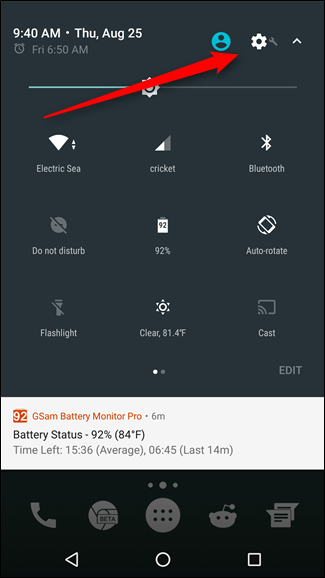
From here, scroll down and find the “Display” section. Tap it.
從這里向下滾動并找到“顯示”部分。 點一下
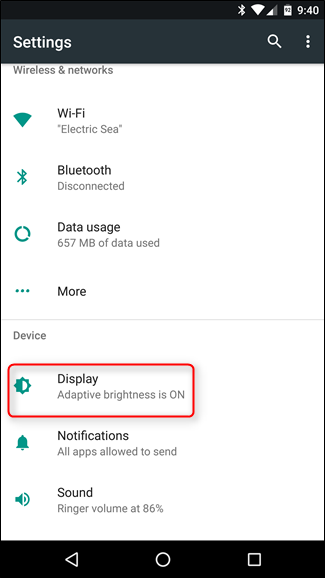
Just below the “Font size” setting, there’s an option called “Display size.” This is what you’re looking for.
在“字體大小”設置的下方,有一個名為“顯示大小”的選項。 這就是您要尋找的。
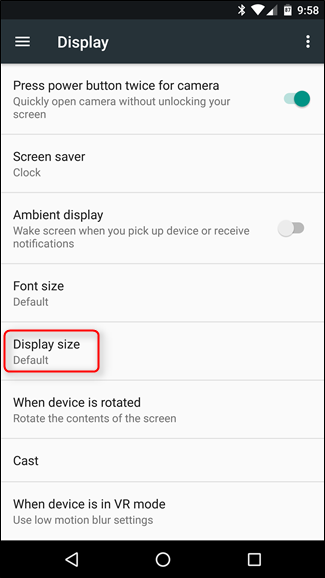
After tapping it, there may be a slight delay while the phone loads the Display Size menu, which is broken down into two parts: the Preview window and actually Display Size slider. There are three different views in the Preview Pane: a text message, app icons, and settings menu. These are all dummy windows, of course, and are just there so you can get a better idea of what on-screen elements will look like once the change is activated. Swipe through these previews to cycle through them.
點擊后,手機加載“顯示尺寸”菜單時可能會稍有延遲,該菜單分為兩部分:“預覽”窗口和“顯示尺寸”滑塊。 預覽窗格中有三種不同的視圖:短信,應用程序圖標和設置菜單。 當然,這些都是虛擬窗口,因此您可以更好地了解激活更改后屏幕上的元素的外觀。 在這些預覽中滑動以循環瀏覽它們。
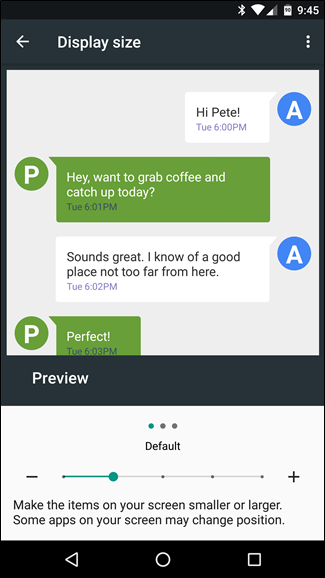
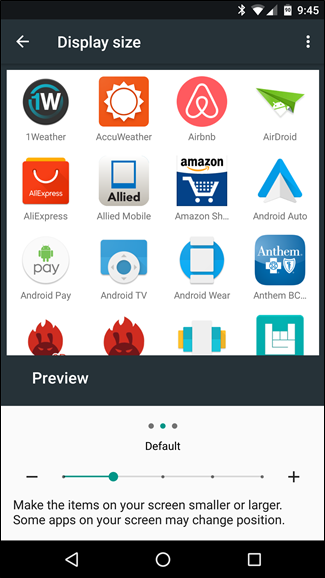
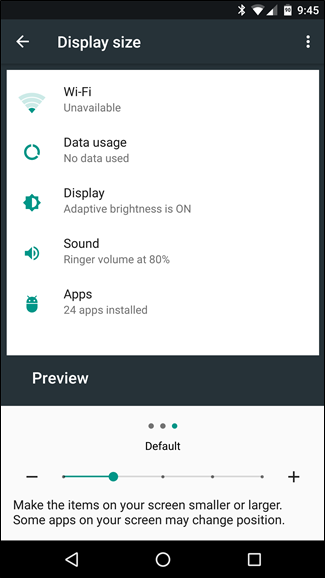
You can adjust the display size by using the plus and minus buttons on either side of the slider—there’s only one option smaller than the default setting, but three larger options. Mess with them all, see which one works best for you. The changes happen in real time, so you’ll instantly know how it’s going to look.
您可以通過使用滑塊兩側的加號和減號按鈕來調整顯示尺寸-只有一個選項比默認設置小,但三個選項更大。 將它們全部弄亂,看看哪一種最適合您。 這些更改是實時發生的,因此您將立即知道它的外觀。
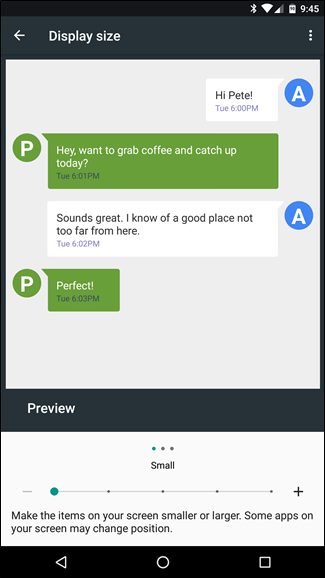
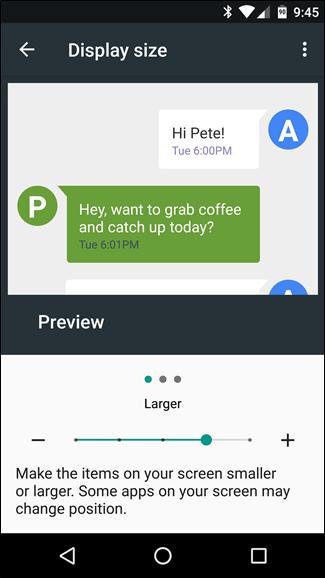
Once you’ve settled on a size, just hit the back button in the upper-left corner. The new sizing will go into effect immediately without the need for a reboot, and you’re done. If you ever want to change it back, simply jump back into the Display Size menu and tweak away.
確定尺寸后,只需點擊左上角的“后退”按鈕。 新的大小調整將立即生效,無需重新啟動,您已完成。 如果您想改回它,只需跳回“顯示大小”菜單并進行調整即可。
或者:使用Android的放大手勢 (Alternatively: Use Android’s Magnification Gesture)
If you’re not keen on changing the overall look of fonts and whatnot, there’s another option: Android’s magnifier. This essentially enables zooming almost anywhere in the OS, save for the notification shade and keyboard.
如果您不希望改變字體的整體外觀,那么還有另一種選擇:Android的放大鏡。 從本質上講,這幾乎可以縮放OS中的任何位置,除了通知欄和鍵盤。
First, navigate to Settings and select “Accessibility.” Scroll?down until you see the System section, then tap on “Magnification Gesture.”
首先,導航到“設置”,然后選擇“輔助功能”。 向下滾動,直到看到“系統”部分,然后點擊“放大手勢”。
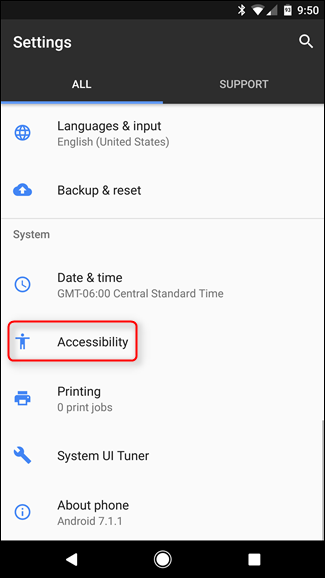
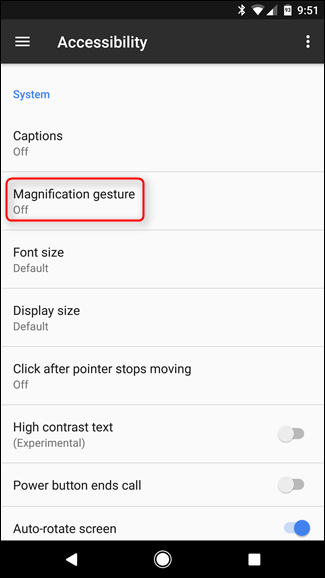
This allows you to triple-tap the screen and then pan around with two or more fingers. If you want, you can even pinch-zoom anywhere.
這使您可以點按三次屏幕,然后用兩個或多個手指平移。 如果需要,您甚至可以在任何地方捏縮放。
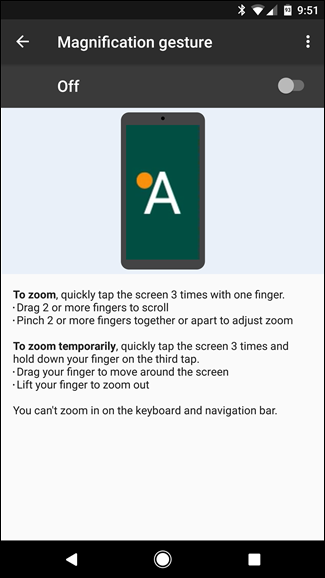
Here’s what a portion of the zoomed screen looks like. The orange border indicates that the device is in zoom mode.
這是部分縮放屏幕的樣子。 橙色邊框表示設備處于縮放模式。
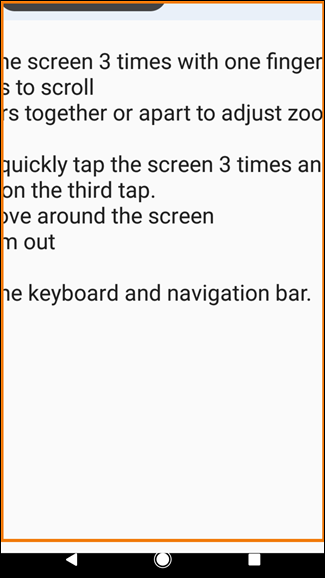
To exit, you triple-tap again. It might take a little practice to get the hang of it. Just remember it’s a triple-tap in quick succession. If you double-tap pause and then tap again or space your taps too far apart, it won’t work.
要退出,請再次點按三次。 要掌握它,可能需要一些練習。 只要記住,這是連續三下三下。 如果您點按兩次暫停,然后再次輕按或將水龍頭分開得太遠,將無法使用。
獎勵功能:大文本和高對比度文本 (Bonus Features: Large Text and High Contrast Text)
On devices running Android 6.x (Marshmallow) or older, there’s also a feature called “Large Text.” This is in addition to the font size options we discussed earlier—it’s sort of a redundant feature, which is probably why it was removed in Nougat.
在運行Android 6.x(棉花糖)或更早版本的設備上,還有一個稱為“大文本”的功能。 這是我們前面討論的字體大小選項的補充,它是一種冗余功能,這可能就是為什么在Nougat中將其刪除的原因。
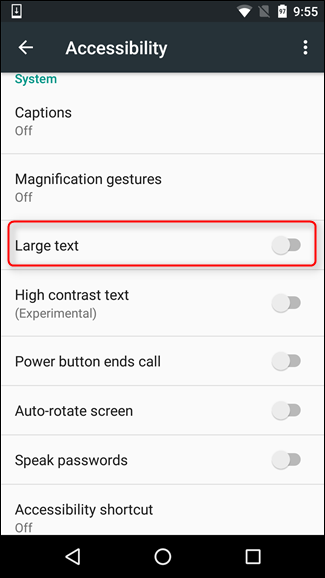
Here’s a side-by-side comparison of the two—normal on the left, large on the right.
這是兩者的并排比較-左側為法線,右側為大。
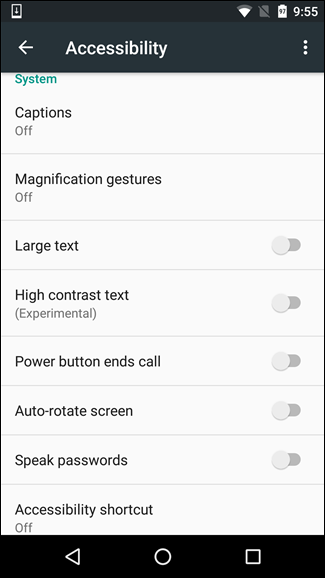
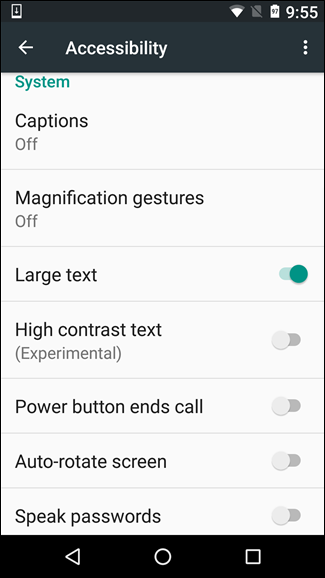
Turning on large text will?pretty much enlarge all the text on the device—home screens, menus, applications—and it doesn’t create undesired or unwanted visual results.
開啟大文本將大大放大設備上的所有文本(主屏幕,菜單,應用程序),并且不會產生不良或不良的視覺效果。
The last feature worth talking about is called “High Contrast Text.” Currently, this option?is labeled as “experimental,” so while it’s likely not going to make your system unstable or unusable, you may experience varying and inconsistent results.
值得一提的最后一個功能稱為“高對比度文字”。 當前,此選項被標記為“實驗性”,因此盡管它可能不會使系統不穩定或無法使用,但您可能會遇到變化且不一致的結果。
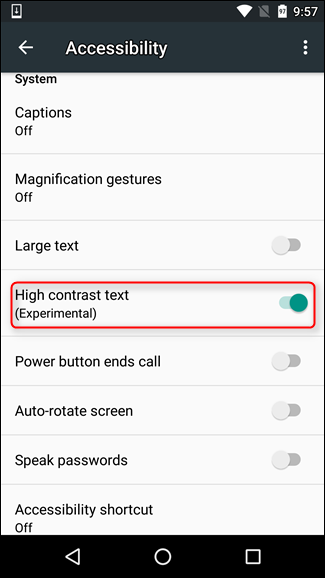
High contrast text basically makes things a little bit darker in system menus, on the keyboard, and in?certain other situations—like when using a colored background in Google Keep, for example.
高對比度的文本基本上會使系統菜單,鍵盤和某些其他情況(例如在Google Keep中使用彩色背景時)的顏色變暗。
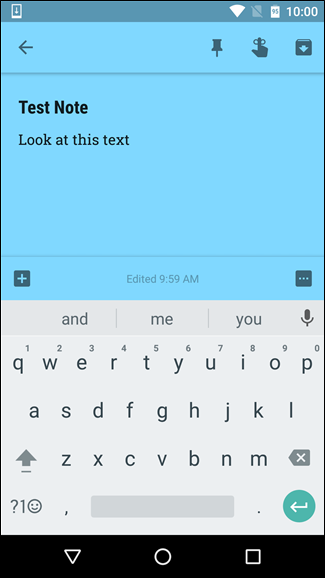
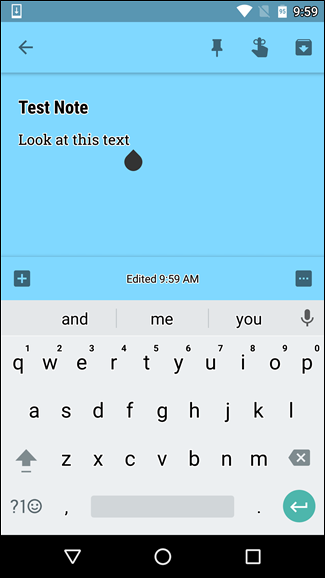
On the left, we see how things look with normal contrast, and on the right is with high contrast text enabled. It’s an obvious difference and does make things easier to read generally speaking, though it will vary from person to person.
左邊是正常對比度的外觀,右邊是啟用高對比度文本的外觀。 盡管這會因人而異,但這是一個明顯的區別,并且確實使事情在總體上更易于閱讀。
Within the Accessibility settings, there are other options you can play with, such as inverting the screen or using TalkBack (for spoken feedback). However, these features we’ve pointed out—magnification and enlarged text, as well as the experimental High Contrast option—are really the least intrusive ways to maintain a clean Android experience.
在“輔助功能”設置中,您可以使用其他選項,例如,翻轉屏幕或使用“話語提示”(語音反饋)。 但是,我們指出的這些功能-放大和放大的文本以及實驗性的高對比度選項-確實是保持純凈Android體驗的最少干擾方式。
翻譯自: https://www.howtogeek.com/268754/how-to-change-the-size-of-text-icons-and-more-in-android-nougat/
android 文本后圖標






golang代碼跳轉配)



)








